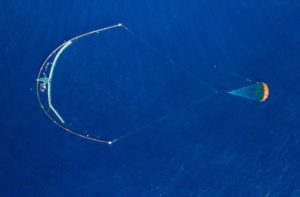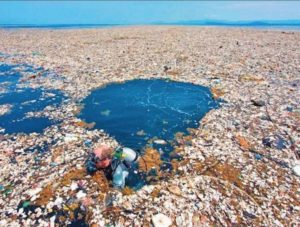
Continua la collaborazione tra il liceo linguistico "“Cattaneo-Dall’Aglio”" e Redacon tramite la rubrica "Speakeasy" curata direttamente dagli studenti, dell'anno scolastico 2019-2020.
-----
The biggest problem our planet is dealing with is pollution and, although our life in the mountains is so far from that of the big cities, we must not delude ourselves with the idea that the problem here does not exist. For this reason we should be careful of the actions we do everyday towards what is our home. Maybe not everyone knows that seas are being inhabited by huge expanses of rubbish and plastic, which are difficult to remove. One of these “rubbish island” is situated in the Pacific Ocean and it’s also known as “the Great Pacific Garbage Patch”. Its size is three times that of France, but it’s going to be cleaned up by a huge floating device designed by Dutch scientists. This device consists of a giant c-shaped tube which creates a barrier and it’s slowed down by a sea anchor. It’s moved by wind and waves together with plastic, so in this way rubbish can be captured by it.
Afterwards, every few months, a support vessel accumulates the gathered debris for recycling. The most interesting characteristic of this system is that it doesn’t only collect large and visible plastic, but also microplastic. In fact the barrier has a three metre deep screen below it, which can trap even the smallest plastic without disturbing marine life. The creator of the project, Boyan Slat, wanted to solve the problem of the costs that would come by using a trawler to collect plastic. In fact, this new device works with the natural forces of the ocean and by selling products made of the plastic which is caught, it should be possible to cover the costs of the cleaning operation in a few years’ time. During the years, scientists have continued to work on this device to improve it and they hope the final design will be able to clean up half of the debris of the Great Pacific Garbage Patch. Today, people also discuss about how to use less plastic or how to re-use it.

Some precautions have already been taken: some cafes serve coffee in compostable cups or supermarkets stock biodegradable bags to carry our groceries home. Moreover, some nations have banned or limited single-use plastics such as bottles, which have been replaced by aluminum cans. But are we really solving the problem? Actually, replacing normal plastic with biodegradable or compostable versions isn’t a solution. Many products are described as ‘compostable’ but can be destroyed only with specific industrial composters. In recent years the focus has been on bioplastics, so those made from plants or other renewable resources, but not all of them are biodegradable. Many everyday objects are made of a kind of bioplastic which contains PLA (polylacted acid), obtained from corn starch. This material is designed to withstand high heat, so a home compost heap won’t reach the high temperatures needed to break it down and people will be obliged to put it in a bin.
For these reasons PLA isn’t better than other plastic. In fact once it ends up in the ocean it can’t degrade. The best solution for everyday life is replacing normal plastic packagings with home compostable ones, but even in this case, if they are discarded in the environment, they can survive up to two years. In water they can disappear in just three months, but we don’t know what products they can release into the marine environment. For these reasons, compostable plastic should be used only if there are enough infrastructures and machines that can appropriately treat it. In recent years, materials that totally degrade have been created; some of them are not only biodegradable or compostable, but edible. For example, a company created edible sauce sachets which can break down in six weeks without any special treatment, if people choose not to eat it. Another solution could be for companies to rethink products that require plastic packaging. As consumers we should prefer plastic that doesn’t biodegrade and has a long life, in order to limit our use of polluting materials. In conclusion, every single action and choice we make every day can make the difference for our planet’s health.
(Rossella Ghirelli, Arianna Merzi e Martina Ceccarelli 4°Q)
***
Il Great Pacific Garbage Patch: nuovi modi per salvare il pianeta

Il più grande problema che il nostro pianeta sta affrontando è l’inquinamento e, nonostante la nostra realtà di montagna sia ben lontana da quella delle grandi città, non dobbiamo illuderci che qui il problema non esista. Per questa ragione dobbiamo fare attenzione alle azioni che compiamo ogni giorno nei confronti di ciò che è la nostra casa. Forse non tutti sanno che i mari sono abitati da vaste distese di rifiuti e plastica, difficili da rimuovere. Una di queste “isole di rifiuti” è situata nell’Oceano Pacifico ed è meglio conosciuta come “The Great Pacific Garbage Patch”. Si estende per una superficie 3 volte maggiore di quella della Francia, ma presto sarà ripulita da un enorme sistema galleggiante progettato da scienziati olandesi. Questo sistema è costituito da un tubo gigante a forma di c che funge da barriera ed è rallentato da un’ancora. Il tubo è mosso dal vento e dalle onde insieme alla plastica, cosicché i rifiuti possano essere raccolti. Successivamente, dopo alcuni mesi, una nave di supporto accumula i rifiuti raccolti per il riciclo. La caratteristica più interessante di questo sistema è che non raccoglie soltanto la plastica grande e visibile ma anche le microplastiche. Infatti la barriera dispone, sotto di essa, di uno schermo profondo tre metri, che riesce a raccogliere anche le plastiche più piccole senza interferire con la flora marina. Il creatore del progetto, Boyan Slat, voleva risolvere i problemi dei costi che sarebbero derivati dall’utilizzo di un peschereccio per raccogliere la plastica. Infatti questo nuovo sistema lavora grazie alle forze naturali dell’Oceano e vendendo i prodotti fatti con la plastica riciclata, sarebbe possibile coprire i costi dell’operazione di pulizia nel giro di pochi anni. Negli anni gli scienziati hanno continuato a lavorare su questo sistema per migliorarlo e sperano che il risultato finale sia in grado di ripulire metà dei rifiuti del Great Pacific Garbage Patch. Ad oggi si discute anche su come usare meno plastica o su come riciclarla. Si sta già intervenendo in alcune situazioni: alcuni bar servono il caffè in tazze compostabili, o i supermercati fanno scorta di borsine biodegradabili per portare a casa la spesa.

Inoltre alcune nazioni hanno proibito o limitato l’utilizzo di plastica monouso, come ad esempio le bottiglie, che sono state sostituite con lattine di alluminio. Ma stiamo davvero risolvendo il problema? In realtà sostituire la normale plastica con versioni biodegradabili o compostabili non è una soluzione. Molti prodotti sono compostabili, ma possono essere distrutti solo attraverso specifici trattamenti di compostaggio industriali. Negli ultimi anni l'attenzione è stata rivolta alle bioplastiche, quindi quelle fatte da piante o altre risorse rinnovabili, ma non tutte sono biodegradabili. Molti oggetti di uso quotidiano sono fatti di una sorta di bioplastica che contiene PLA (acido polilattico), ricavato dall'amido di mais. Questo materiale è progettato per resistere al calore elevato, quindi un sacco di compost domestico non raggiungerà le alte temperature necessarie per distruggerlo e saremo obbligati a gettarlo in unbidone dell’immondizia. Per questi motivi il PLA non è migliore di altra plastica. Infatti una volta che finisce nell'oceano non può degradarsi.
La migliore soluzione per la vita di tutti i giorni è quella di sostituire i normali imballaggi in plastica con quelli compostabili a casa, ma anche in questo caso, se vengono scartati nell'ambiente, possono sopravvivere fino a due anni. In acqua possono scomparire in soli tre mesi, ma non sappiamo quali prodotti possano rilasciare nell'ambiente marino. Per questi motivi, la plastica compostabile dovrebbe essere utilizzata solo se vi sono infrastrutture e macchine sufficienti per trattarla in modo adeguato. Negli ultimi anni sono stati creati materiali che si degradano totalmente; alcuni di essi non sono solo biodegradabili o compostabili, ma commestibili.
Ad esempio, un'azienda ha creato bustine di salsa commestibili che possono essere scomposte in sei settimane senza alcun trattamento speciale, se si decide di non mangiarle. Un'altra soluzione potrebbe essere che le aziende decidano di riconsiderare i prodotti che richiedono imballaggi in plastica. Come consumatori dovremmo preferire la plastica che non biodegrada e che ha una lunga durata, al fine di limitare il nostro uso di materiali inquinanti. In conclusione, ogni singola azione e scelta che facciamo ogni giorno può fare la differenza per la salute del nostro pianeta.
(Rossella Ghirelli, Arianna Merzi e Martina Ceccarelli 4°Q)







